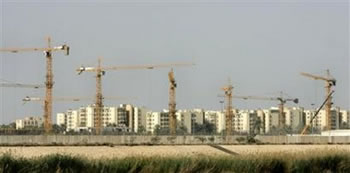Entered into the database on Saturday, April 15th, 2006 @ 19:04:27 MST
The fortress-like compound rising beside the Tigris River here will
be the largest of its kind in the world, the size of Vatican City, with the
population of a small town, its own defense force, self-contained power and
water, and a precarious perch at the heart of Iraq's turbulent future. The new U.S. Embassy also seems as cloaked in secrecy as the ministate
in Rome. "We can't talk about it. Security reasons," Roberta Rossi, a spokeswoman
at the current embassy, said when asked for information about the project. A British tabloid even told readers the location was being kept secret —
news that would surprise Baghdadis who for months have watched the forest of
construction cranes at work across the winding Tigris, at the very center of
their city and within easy mortar range of anti-U.S. forces in the capital,
though fewer explode there these days. The embassy complex — 21 buildings on 104 acres, according to a U.S.
Senate Foreign Relations Committee report — is taking shape on riverside
parkland in the fortified "Green Zone," just east of al-Samoud, a
former palace of Saddam Hussein's, and across the road from the building where
the ex-dictator is now on trial. The Republican Palace, where U.S. Embassy functions are temporarily housed
in cubicles among the chandelier-hung rooms, is less than a mile away in the
4-square-mile zone, an enclave of American and Iraqi government offices and
lodgings ringed by miles of concrete barriers. The 5,500 Americans and Iraqis working at the embassy, almost half listed as
security, are far more numerous than at any other U.S. mission worldwide. They
rarely venture out into the "Red Zone," that is, violence-torn Iraq. This huge American contingent at the center of power has drawn criticism. "The presence of a massive U.S. embassy — by far the largest in
the world — co-located in the Green Zone with the Iraqi government is
seen by Iraqis as an indication of who actually exercises power in their country,"
the International Crisis Group, a European-based research group, said in one
of its periodic reports on Iraq. State Department spokesman Justin Higgins defended the size of the embassy,
old and new, saying it's indicative of the work facing the United States here. "It's somewhat self-evident that there's going to be a fairly sizable
commitment to Iraq by the U.S. government in all forms for several years,"
he said in Washington. Higgins noted that large numbers of non-diplomats work at the mission —
hundreds of military personnel and dozens of FBI agents, for example, along
with representatives of the Agriculture, Commerce and other U.S. federal departments. They sleep in hundreds of trailers or "containerized" quarters scattered
around the Green Zone. But next year embassy staff will move into six apartment
buildings in the new complex, which has been under construction since mid-2005
with a target completion date of June 2007. Iraq's interim government transferred the land to U.S. ownership in October
2004, under an agreement whose terms were not disclosed. "Embassy Baghdad" will dwarf new U.S. embassies elsewhere, projects
that typically cover 10 acres. The embassy's 104 acres is six times larger than
the United Nations compound in New York, and two-thirds the acreage of Washington's
National Mall. Original cost estimates ranged over $1 billion, but Congress appropriated only
$592 million in the emergency Iraq budget adopted last year. Most has gone to
a Kuwait builder, First Kuwaiti Trading & Contracting, with the rest awarded
to six contractors working on the project's "classified" portion —
the actual embassy offices. Higgins declined to identify those builders, citing security reasons, but said
five were American companies. The designs aren't publicly available, but the Senate report makes clear it
will be a self-sufficient and "hardened" domain, to function in the
midst of Baghdad power outages, water shortages and continuing turmoil. It will have its own water wells, electricity plant and wastewaster-treatment
facility, "systems to allow 100 percent independence from city utilities,"
says the report, the most authoritative open source on the embassy plans. Besides two major diplomatic office buildings, homes for the ambassador and
his deputy, and the apartment buildings for staff, the compound will offer a
swimming pool, gym, commissary, food court and American Club, all housed in
a recreation building. Security, overseen by U.S. Marines, will be extraordinary: setbacks and perimeter
no-go areas that will be especially deep, structures reinforced to 2.5-times
the standard, and five high-security entrances, plus an emergency entrance-exit,
the Senate report says. Higgins said the work, under way on all parts of the project, is more than
one-third complete. Associated Press news researcher Jennifer Farrar in New York contributed to
this report.
